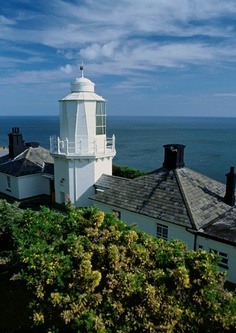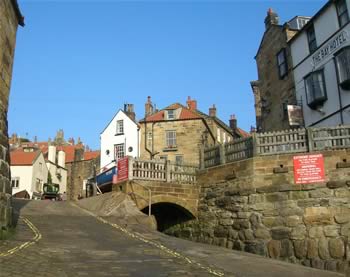
Haydock Place
Endeavour Cottage in Whitby located in the courtyard of Haydock Place.
IT is impossible to speak too highly of the walks round Whitby. The keen, bracing, appetizing air; the sense of spaciousness and freedom; the purple heather-clad heights and valleys, and the extensive outlook, richly reward the toil entailed. I will give suggestions for a number of the most inviting walks, but these are, of course, capable of many modifications and extensions.
The Moors, which are too many such an alluring feature of the country near Whitby, can be reached by proceeding for about 3 miles along the high road towards Scarborough, the high road towards Pickering, or the high road towards Guisborough. Their grandeur at any time makes an irresistible appeal to lovers of nature, but of course it is when the heather is in bloom that their charm is greatest.
After a spell of wet weather, the moors are in places sodden and bog-like, and it is advisable to keep to main roads or well-defined cart-tracks. The following hints are worth remembering.
1 When in doubt as to direction, bear in mind that the way to get off the moors is to walk down the valleys 2 bright green moss more often than not covers bogs avoid such patches 3 the tracks made by the sheep are always safe paths 4 a pocket compass and small railway and
bus time tables take up little room, and are often useful.
TO ROBIN HO0D’S BAY
The road route lies through Hawsker leaving that village by the road to the left (that which goes straight forward leads to Scarborough. Bay Town will be seen at the foot of a long and, in places, very steep descent. The walk southward from Whitby to Robin Hood’s Bay,
though somewhat arduous, is of great interest. The cliffs are in places 300 ft. high, and the outlook seaward is superb the whole distance. Much of the shipping takes a course quite near to the cliffs, and forms an attractive feature of the ramble.
very steep descent. The walk southward from Whitby to Robin Hood’s Bay,
though somewhat arduous, is of great interest. The cliffs are in places 300 ft. high, and the outlook seaward is superb the whole distance. Much of the shipping takes a course quite near to the cliffs, and forms an attractive feature of the ramble.
For the cliff-walk of nearly 9 miles, directions are hardly necessary. Mount the I99 steps to the church yard, and then turn leftward to the cliff. After following the path for about half a mile, the almost coal-black Saltwick Nab will be seen jutting out seawards and forming the northern protection of Saltwick Bay.
The Nab may well be made the object of a special excursion. But some care is necessary in scrambling about the Nab, for the shale is very slippery.
It is dangerous to attempt to reach Saltwick by the shore when the tide is coming in, as the water rises quickly, and the cliffs are unclimbable. When the upper route is being followed, go on the footpath and continue on the cliff-top through a farmyard, after which take one of the many paths over the grass down to the sands, which are very sheltered. At low water, the slippery Scar and the rough rocks near the East Pier can be thoroughly explored, and yield much treasure-trove to naturalists and geologists. From the point where the descent is made the path is seen to bend slightly inland through a farmyard. Follow the foot path in distinct in places until the spick and span Light house is reached, at a distance of 2 miles from Whitby.
The High Lighthouse is itself 44 ft. high, and stands at the cliff edge, 240 ft. above sea-level. Its purpose on this dangerous and rocky coast is to give warning of the rocks which flank ‘Whitby to the south of the piers within the line of the Bell Buoy. The light is visible in clear weather for 22  miles, and shows a white light occulting every half-minute, with a red sector over Whitby Scar. In a. building close to the lighthouse. there used to be powerful siren, giving in foggy weather four quick blasts every ninety seconds. It was jocularly known as the “Whitby mad bull. A road connects the lighthouse with the Scarborough high road at a point about 2 miles from Whitby. The path behind the Lighthouse continues by a somewhat up—and down course to the Hess, which forms the northern horn of Robin Hood’s Bay. By continuing along the cliff one finally drops by a. somewhat abrupt descent into the main street of the town
miles, and shows a white light occulting every half-minute, with a red sector over Whitby Scar. In a. building close to the lighthouse. there used to be powerful siren, giving in foggy weather four quick blasts every ninety seconds. It was jocularly known as the “Whitby mad bull. A road connects the lighthouse with the Scarborough high road at a point about 2 miles from Whitby. The path behind the Lighthouse continues by a somewhat up—and down course to the Hess, which forms the northern horn of Robin Hood’s Bay. By continuing along the cliff one finally drops by a. somewhat abrupt descent into the main street of the town
.
Those who want an extended walk may be recommended to turn inland at Robin Hood’s Bay to Thorpe, ascend to Fylingdales Moor, and so to Falling Foss; returning from the latter spot by the footpath along Little Beck to Sleights, and thence to Whitby by train or bus. This is a long round, and will take a whole day. Another alternative, if the tide be low, is to scramble along the rough and not very inviting foreshore from Robin Hood’s Bay towards the Peak. The cliff-path can also be taken, though it is rather broken and in places not easily traced
Back to Whitby History -Back to Whitby Blog
A walking guide of the town and its attractions click Whitby

Endeavour Cottage in Whitby located in the courtyard of Haydock Place.

Across the rooftops of Whitby towards the abbey

A view of Whitby Abbey from a cottage window.

We could provide high occupancy.
Want more booking for your holiday accommodation?
List your property with us. no contract red tape, no setup fee. Just bookings if and when you want them.
Whitby Holiday Cottages Letting Agency.